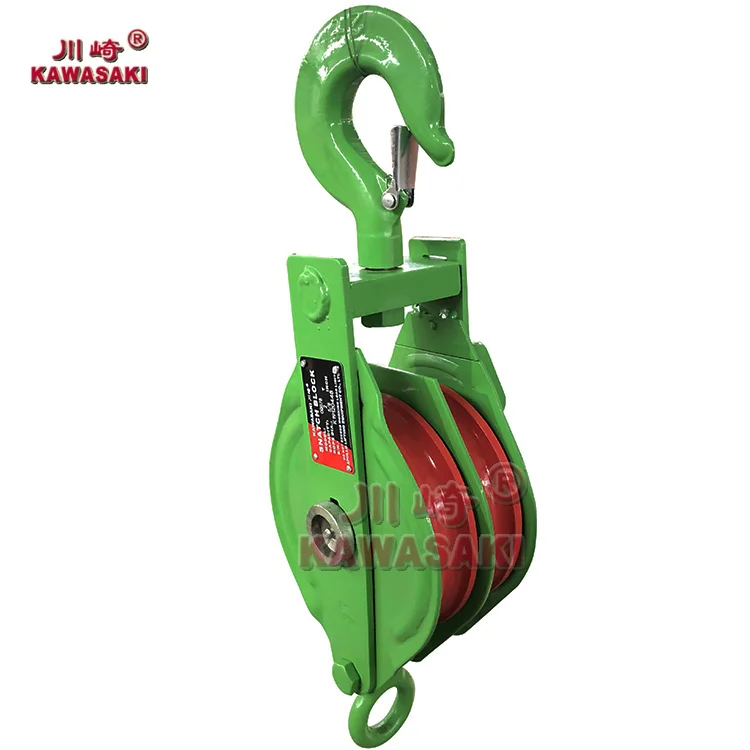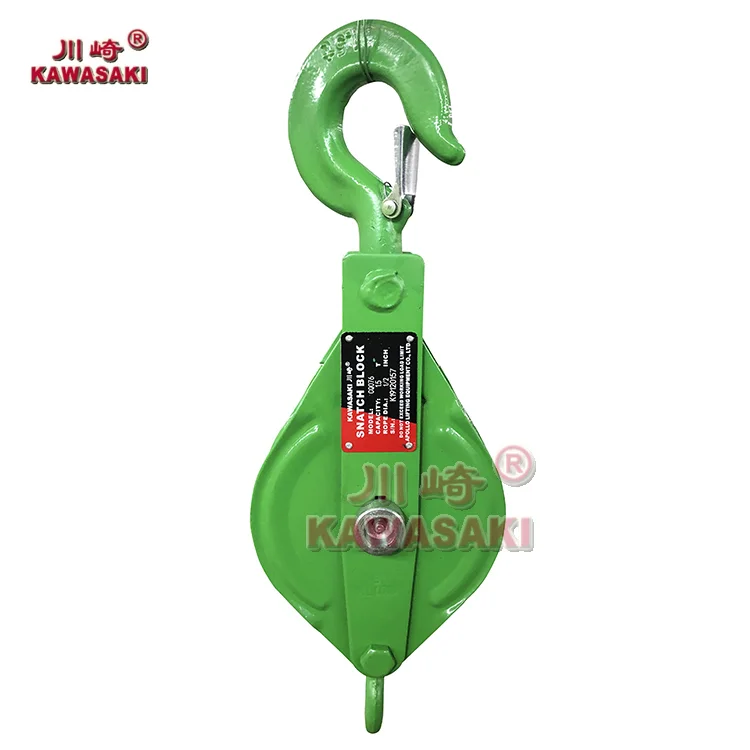What Are the Fundamental Concepts Behind Sheave Blocks and Pulley Blocks?
How Do Sheave Blocks and Pulley Blocks Operate Mechanically, and What Sets Them Apart?
Sheave blocks and pulley blocks are neat tools that help lift or move heavy things by guiding a rope or cable. A pulley block has one wheel, called a pulley, that spins on a shaft to change the rope’s direction. A sheave block is cooler—it’s got one or more grooved wheels, called sheaves, in a strong case, made for bigger, tougher jobs.
Sometimes folks mix up the names, but in serious work, they’re not the same. Sheave blocks are like heavy-duty champs, built for big loads with lots of wheels to share the weight. Pulley blocks are simpler, usually with one wheel for easy tasks, like pulling something a different way.
When Did These Tools Begin Playing a Role in Industrial Applications?
A long time ago, people like the ancient Greeks used pulleys to build things or set up ships. As factories got bigger, pulleys got better. Old wooden ones turned into strong metal ones, like those made from alloy steel, to lift super heavy stuff. Now, in places like shipyards, building sites, and mines, these tools are a big deal for moving loads safely.
How Do Structural Designs Vary Between Sheave Blocks and Pulley Blocks?
What Are the Core Components and Materials Used in Their Construction?
Both sheave blocks and pulley blocks have similar parts: a frame (like a shell), an axle, a wheel (sheave or pulley), bearings to keep things spinning smooth, and hooks or shackles to connect them. But what they’re made of makes them different. Tough alloy steel is used for hard jobs because it lasts forever. For example, APOLLO’s KAWASAKI PULLEY BLOCK CQ has a strong powder coat finish and a super tough build to handle rough places.
In wet spots like the ocean, special coatings stop rust from wrecking these tools, keeping them ready for action.
How Do Load Distribution Mechanisms Differ Between These Two Systems?
Sheave blocks are great for big jobs because they use lots of ropes and wheels to spread the weight around. This makes each rope carry less, so it’s super safe. Pulley blocks usually have just one wheel and are perfect for simple jobs, like changing where a rope pulls without lifting tons of weight.
How Are They Integrated With Wire Rope or Cable Systems?
To work right, the wheel’s grooves gotta fit the rope or cable like a glove. If they don’t match, the rope might slip or wear out fast. In big lifting jobs, wire ropes need to fit the sheave’s grooves perfectly to stay strong. APOLLO makes their wheels super smooth to cut down on rubbing, which helps things move easy and last a long time.
How Do Their Functional Capabilities Differ Across Operational Contexts?
Can They Handle Both Static and Dynamic Loads Effectively?
Pulley blocks are awesome for static lifts, where the load stays put once it’s up, like hanging a big sign. Sheave blocks are better for dynamic jobs, where stuff moves around a lot, because their many ropes keep things steady, such as APOLLO’s KAWASAKI PULLEY BLOCK WTS.
Are They Equally Suitable for Vertical and Horizontal Lifting Tasks?
Sheave blocks are the stars of up-and-down lifting because their multi-rope setup can handle heavy weights without breaking. Pulley blocks can pull side-to-side, but they might need extra gear to stay straight with a big load. Sheave blocks are like the cool kids for vertical lifts!
How Do They Influence System Efficiency Through Friction Management?
Friction is like a sneaky gremlin that slows things down and wears out ropes. Good bearings, like sealed ball bearings, make the wheels spin easier and save energy. APOLLO uses top-notch bearings to keep their blocks running smooth as butter for a long time.
Which Industries Rely on These Tools Most Heavily?
Why Are They Crucial in Marine Rigging and Offshore Applications?
In the ocean, everything gets wet and salty, so tools gotta fight rust. Sheave blocks with stainless steel or special coatings, like APOLLO’s, stay strong in salty air. Their many wheels let ships lift heavy stuff, like boxes or gear, with super control when loading or unloading.
What Role Do They Play on Construction Sites?
Construction sites are always lifting things like steel beams or concrete slabs. Sheave blocks make it easy to hoist stuff up high or move it side to side with cranes or winches. APOLLO’s electric winches team up with these blocks to make building quick and safe, like a well-oiled machine.
How Are They Utilized in Mining Operations and Heavy Equipment Handling?
Mines are super tough places with dust, water, and heavy loads. Sheave blocks made from strong alloy steel with heat-treated gears, like APOLLO’s, last a long time in mines. They help lift big machines or move ore without breaking, even in really hard conditions.
What Should You Consider When Selecting Between Sheave Blocks and Pulley Blocks?
Which Criteria Should Guide Your Selection Process?
Picking the right block depends on three big things: how heavy your load is, how often you use it, and where you’re working. For big, heavy lifts with lots of ropes, grab a sheave block. For small jobs, like redirecting a rope, a pulley block does the trick. Make sure the wheel’s groove fits your rope just right to stop slips.
Why Are Safety Ratings and Compliance Standards So Critical?
Safety rules keep everyone out of trouble. Certified blocks, like APOLLO’s pulley blocks with ISO9001 and CE approval, mean you can trust them not to break. Always check that your gear follows local safety laws to keep workers and stuff safe.
How Does APOLLO Integrate Advanced Engineering Into Block Design?
APOLLO makes super cool lifting tools with tons of know-how since 1986. Their labs in Osaka, started in 2001, mix Japanese smarts with Taiwanese skill to build awesome blocks for tough jobs. They make all sorts of gear, like electric hoists, chain hoists, winches, clamps, trolleys, and pallet trucks, plus really strong pulley blocks for big tasks.
APOLLO lets you tweak everything, from how the block works (like making it explosion-proof) to how it looks (like picking fun colors or adding your logo). Their strict quality checks, following ISO rules, make sure every block is safe and trusty.
Which APOLLO Products Optimize Performance in High-Demand Scenarios?
What Makes Their Sheave Block Models Ideal for Heavy-Duty Lifting Applications?
The KAWASAKI PULLEY BLOCK CQ is a rock star for tough lifts. It’s tested to handle twice its normal weight before it’s packed, so it’s super reliable. Its powder coat finish and tough build make it perfect for rough spots. With a 4x safety factor, it stays safe even if things get wild during a lift.
Which Pulley Block Solutions Offer Precision Control Over Lightweight Tasks?
For smaller jobs, like setting up stage lights or moving parts in a factory, APOLLO’s single-sheave pulley blocks with electric chain hoists are perfect. They’re small but give great control. You can add cool stuff like rainproofing or pick a fun color to match your style.
How Can You Maximize Longevity Through APOLLO’s Engineering Innovations?
What Coating Technologies Enhance Corrosion Resistance Over Time?
APOLLO uses neat tricks, like spray painting, electroplating, or nickel-plated chains, to stop rust. You can pick finishes like galvanized or blackened to fit your job. These coatings keep blocks strong and save you from fixing them a lot, which saves money.
Can You Customize Equipment Based on Project-Specific Needs?
You bet! APOLLO lets you change everything, like voltage (110V–575V) or adding explosion-proofing for risky spots. You can even pick cool colors or add your logo. This makes sure your gear fits your job like a glove and stays safe.
Does APOLLO Support Maintenance Protocols Post-Sale?
Yes. APOLLO gives you video guides on how to use and fix their blocks. They offer spare parts and a one-year warranty to keep your gear in tip-top shape. Their help makes sure your blocks last a long time.
FAQs
Q1: Is there any difference between a sheave block vs a pulley block?
A: Yes! A sheave block has lots of grooved wheels in one case for heavy loads with multiple ropes. A pulley block is simpler, usually with one wheel for changing direction or light lifts.
Q2: Can I use both types interchangeably?
A: Not really—it depends on your job. Sheave blocks are for heavy, moving loads, while pulley blocks are for simpler, lighter tasks. Check your load and workspace first.
Q3: How do I know if my wire rope fits my pulley block properly?
A: Make sure the wheel’s groove matches your rope’s size exactly. If it doesn’t fit, the rope could slip or wear out, which isn’t safe for lifting.


